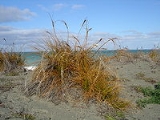
Pingao
Encyclopedia
Pingao, Ficinia spiralis, also known as golden sand sedge is a coastal sedge
endemic
to New Zealand
(including the Chatham Islands
). Originally widespread, it has suffered severely from competition with introduced marram grass
and animal grazing and now has only a patchy distribution.
Leaves from this plant are used by Maori in weaving. The leaves turn a bright yellow as they dry.
Pīngao is a stout, grass-like plant, 30–90 cm tall, from the sedge family, found on active sand dunes. It is found only in New Zealand and is easily distinguished from other species that grow on sand dunes.
Most plants produce long, prostrate, tough rope-like stems (rhizomes) that creep along the sand surface until buried by shifting sand, leaving just the upper portion of leaves exposed. Some southern South Island populations produce dense tussock-like plants without extensive rhizomes.
Numerous tough, roughly textured leaves are borne in dense tufts on well-spaced, short, upright stems (tillers), along the length of rhizomes. The narrow leaves are 2–5 mm wide, with colour ranging from green through yellow to orange. Seen from a distance, pīngao patches have a distinctive orange hue. The length, width and strength of the leaves for weaving vary among pīngao populations growing in different areas.
Small, dark brown flowers appear in spring and are arranged spirally in tight clusters around the upper 10–30 cm of the upright stem (culm), interspersed with leaf-like bracts. The seeds are shiny, dark brown, egg-shaped, 3–5 mm long, and ripen and fall in early summer.
The plant can multiply itself by stolons.
Cyperaceae
Cyperaceae are a family of monocotyledonous graminoid flowering plants known as sedges, which superficially resemble grasses or rushes. The family is large, with some 5,500 species described in about 109 genera. These species are widely distributed, with the centers of diversity for the group...
endemic
Endemic (ecology)
Endemism is the ecological state of being unique to a defined geographic location, such as an island, nation or other defined zone, or habitat type; organisms that are indigenous to a place are not endemic to it if they are also found elsewhere. For example, all species of lemur are endemic to the...
to New Zealand
New Zealand
New Zealand is an island country in the south-western Pacific Ocean comprising two main landmasses and numerous smaller islands. The country is situated some east of Australia across the Tasman Sea, and roughly south of the Pacific island nations of New Caledonia, Fiji, and Tonga...
(including the Chatham Islands
Chatham Islands
The Chatham Islands are an archipelago and New Zealand territory in the Pacific Ocean consisting of about ten islands within a radius, the largest of which are Chatham Island and Pitt Island. Their name in the indigenous language, Moriori, means Misty Sun...
). Originally widespread, it has suffered severely from competition with introduced marram grass
Marram grass
Ammophila is a genus consisting of two or three very similar species of grasses; common names for these grasses include Marram Grass, Bent Grass, and Beachgrass...
and animal grazing and now has only a patchy distribution.
Leaves from this plant are used by Maori in weaving. The leaves turn a bright yellow as they dry.
Pīngao is a stout, grass-like plant, 30–90 cm tall, from the sedge family, found on active sand dunes. It is found only in New Zealand and is easily distinguished from other species that grow on sand dunes.
Most plants produce long, prostrate, tough rope-like stems (rhizomes) that creep along the sand surface until buried by shifting sand, leaving just the upper portion of leaves exposed. Some southern South Island populations produce dense tussock-like plants without extensive rhizomes.
Numerous tough, roughly textured leaves are borne in dense tufts on well-spaced, short, upright stems (tillers), along the length of rhizomes. The narrow leaves are 2–5 mm wide, with colour ranging from green through yellow to orange. Seen from a distance, pīngao patches have a distinctive orange hue. The length, width and strength of the leaves for weaving vary among pīngao populations growing in different areas.
Small, dark brown flowers appear in spring and are arranged spirally in tight clusters around the upper 10–30 cm of the upright stem (culm), interspersed with leaf-like bracts. The seeds are shiny, dark brown, egg-shaped, 3–5 mm long, and ripen and fall in early summer.
The plant can multiply itself by stolons.

